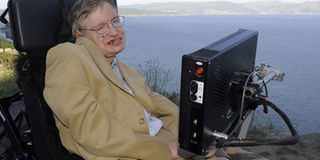Physicist Stephen Hawking's journey to limelight

In this file photo taken on September 25, 2008, professor Stephen Hawking is pictured during a visit to Cape Finisterre, some 90 km from Santiago, northwestern Spain. PHOTO | MIGUEL RIOPA | AFP
What you need to know:
- His thesis was titled Properties of Expanding Universes and was recently uploaded online for the first time by Cambridge University.
- Hawking used his disability as an inspiration to push the boundaries of science and research.
Stephen W. Hawking, one of the greatest theoretical physicists that ever lived, has died.
Hawking’s star dimmed at the age of 76, bringing to an end an incredible life.
Hawking – a towering intellectual figure, whose significant contributions to modern physics have been compared to those of Albert Einstein – is a paragon of what true grit, indefatigable resilience, and a never-say-die indomitable spirit can achieve.
Born in Oxford, England on January 8, 1942, Hawking was brought up by a “free-thinking” radical mother and a father who was an expert in tropical diseases.
MATHEMATICS
After attending St Albans School, he was awarded a scholarship to the University College, Oxford, in 1959 at the age of 17.
He wanted to study mathematics, but it was not offered at the college, so he opted to study physics, although his father, Frank, would have preferred that the young man studies medicine.
Hawking’s teachers say that although he exhibited far unusual capabilities compared to his classmates, he was a stubborn and mediocre student who hardly accorded his education the seriousness it deserved.
By his own admission, Hawking never put much effort in undergraduate, saying that he only studied for 1,000 hours during the three years he was in Oxford.
“You were supposed to be either brilliant without effort, or accept your limitations,” Hawking wrote in his 2013 autobiography My Brief History.
At University College, Hawking – well aware that he was a problematic student, told his professors that if they gave him a first class honours he would proceed to Cambridge University, and if they gave him a second class honours, he threatened to stay at Oxford.
THESIS
The tutors gave him a first-class degree. In 1965, under the supervision of Dennis Sciama, Hawking earned his PhD.
His thesis was titled Properties of Expanding Universes and was recently uploaded online for the first time by Cambridge University, causing the website to momentarily crash due to the increased downloads.
Hawking would then become a tutorial fellow and later worked with fellow scientist Roger Penrose to merge Einsten’s general relativity theory and quantum theory.
Among his greatest scholarly contributions was exploring and explaining gravity and the properties of black holes, arguing that black holes were not so black after all, and that they eventually fizzle out and emit radiations that would later be known as ‘Hawking Radiation”.
ALS
His book A Brief History of Time, published in 1988, stayed on the Sunday Times bestseller for a whooping 237 weeks, making it to the Guinness Book of Records.
However, it is Hawking’s resilience, resolve and will to live that has baffled and inspired many across the globe.
In 1963, at the age of 21, Hawking was diagnosed with ALS (amyotrophic lateral sclerosis), a motor neuron disease which turns fatal within a short time.
Doctors told him that his disease would progress very fast and that he would not live very long following his diagnosis.
The young Hawking, who had just joined graduate school, was initially depressed and felt that he had nothing to live for.
INSPIRATION
However, in what seems like a medical miracle, the disease progressed slower than the doctors had initially predicted, and Hawking went on to live for 55 years after his diagnosis.
Hawking used his disability as an inspiration to push the boundaries of science and research.
So determined that he never allowed the disease to cripple his mind.
The disease meant that Hawking would gradually loose control of his muscles and simple tasks such as dressing and bathing would prove extremely laborious.
Despite these challenges, Hawking never lost his will to live and he approached life with a unprecedented zeal, positive thinking and optimistic attitude.
Rarely would he discuss his disease or give it prominence, preferring to talk about his research and physics.
PNEUMONIA
In the years following his diagnosis, Hawking tried to be as independent as possible, often turning down assistance from others and resisted using a wheelchair until it was absolutely necessary.
The year 1985 would prove a landmark for the scientist who suffered a life-threatening bout of pneumonia.
Hawking was severely ill that his doctors asked his wife Jane if they should get him off life support.
His wife made the decision to have him undergo tracheotomy – a surgery that saved his life – but also completely destroyed his voice.
From 1997, Hawking has used a speech synthesiser to communicate in a computerised voice with an American accent.
MARRIAGE
The sophisticated software, developed by Intel, allowed Hawking to check his email, surf the Internet and write his lectures.
Hawking was married twice; the first time to Jane Wilde, whom he met in a street in Cambridge.
They had three children; Lucy, Robert and Tim, and were married for 30 years before they divorced in 1995.
He would later marry one of his nurses, Elaine Mason, for 11 years and divorced in 2007.
Hawking was known to have a “wicked sense of humour’ and his students loved him not just for his brilliance, but because he would be dramatic sometimes, running over student’s toes with his wheelchair if he felt they were too difficult.
The life of Hawking has been marked with a series of bizarre coincidences connected to the greatest physicists; Hawking was born on January 8, exactly 378 years since the death of the great physicist Galileo Galilei- and died on March 14, the birth date of Albert Einstein.





